lock RENAULT FLUENCE Z.E. 2012 User Guide
[x] Cancel search | Manufacturer: RENAULT, Model Year: 2012, Model line: FLUENCE Z.E., Model: RENAULT FLUENCE Z.E. 2012Pages: 195, PDF Size: 5.23 MB
Page 27 of 195
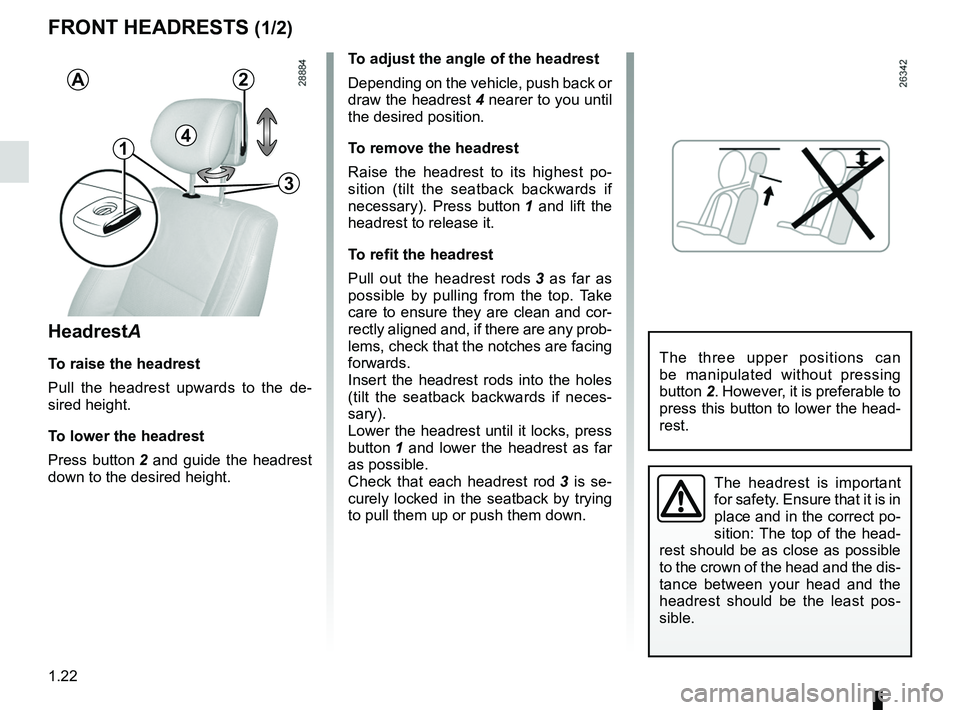
headrest................................................ (up to the end of the DU)
front seats adjustment ...................................... (up to the end of the DU)
adjusting your driving position .............. (up to the end of the DU)
1.22
ENG_UD29257_1
Appuis-tête avant (L38 électrique - Renault)
ENG_NU_914-4_L38e_Renault_1
Jaune NoirNoir texte
Headrests - Seats
FrONt heADreStS (1/2)
headrest A
to raise the headrest
Pull the headrest upwards to the de -
sired height.
t o lower the headrest
Press button 2 and guide the headrest
down to the desired height. t
o adjust the angle of the headrest
Depending on the vehicle, push back or
draw the headrest 4 nearer to you until
the desired position.
t o remove the headrest
Raise the headrest to its highest po -
sition (tilt the seatback backwards if
necessary). Press button 1 and lift the
headrest to release it.
t o refit the headrest
Pull out the headrest rods 3 as far as
possible by pulling from the top. Take
care to ensure they are clean and cor-
rectly aligned and, if there are any prob-
lems, check that the notches are facing
forwards.
Insert the headrest rods into the holes
(tilt the seatback backwards if neces -
sary).
Lower the headrest until it locks, press
button 1 and lower the headrest as far
as possible.
Check that each headrest rod 3 is se -
curely locked in the seatback by trying
to pull them up or push them down.
The headrest is important
for safety. Ensure that it is in
place and in the correct po-
sition: The top of the head -
rest should be as close as possible
to the crown of the head and the dis-
tance between your head and the
headrest should be the least pos -
sible.
2
3
A
1
The three upper positions can
be manipulated without pressing
button 2. However, it is preferable to
press this button to lower the head-
rest.
4
Page 28 of 195
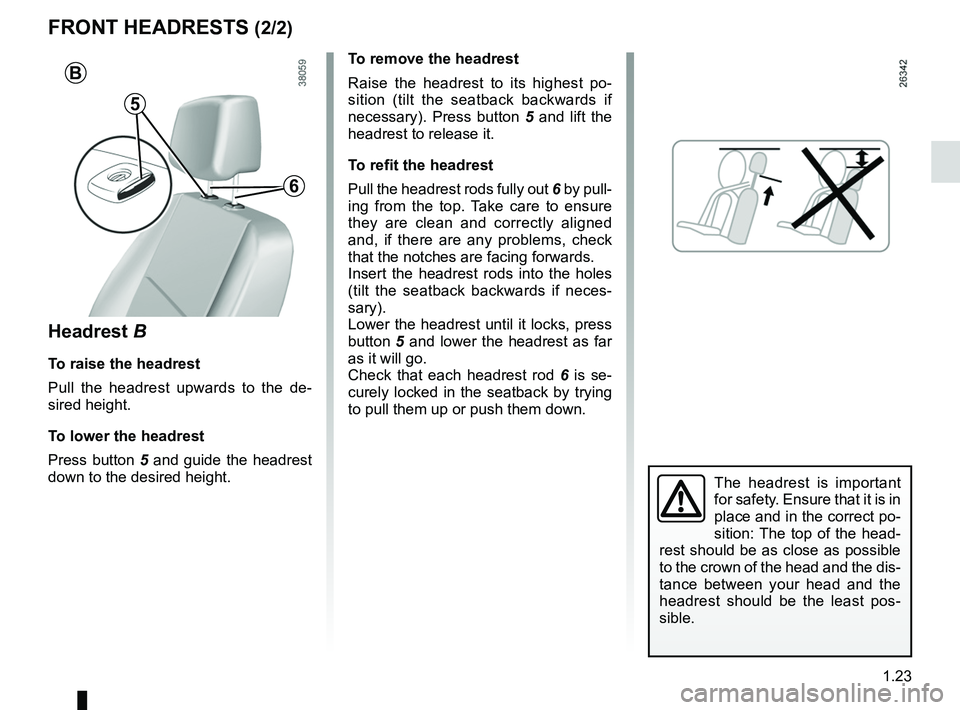
JauneNoirNoir texte
1.23
ENG_UD29257_1
Appuis-tête avant (L38 électrique - Renault)
ENG_NU_914-4_L38e_Renault_1
headrest B
to raise the headrest
Pull the headrest upwards to the de -
sired height.
t o lower the headrest
Press button 5 and guide the headrest
down to the desired height. t
o remove the headrest
Raise the headrest to its highest po -
sition (tilt the seatback backwards if
necessary). Press button 5 and lift the
headrest to release it.
t o refit the headrest
Pull the headrest rods fully out 6 by pull-
ing from the top. Take care to ensure
they are clean and correctly aligned
and, if there are any problems, check
that the notches are facing forwards.
Insert the headrest rods into the holes
(tilt the seatback backwards if neces -
sary).
Lower the headrest until it locks, press
button 5 and lower the headrest as far
as it will go.
Check that each headrest rod 6 is se -
curely locked in the seatback by trying
to pull them up or push them down.
FrONt heADreStS (2/2)
B
5
6
The headrest is important
for safety. Ensure that it is in
place and in the correct po-
sition: The top of the head -
rest should be as close as possible
to the crown of the head and the dis-
tance between your head and the
headrest should be the least pos -
sible.
Page 30 of 195
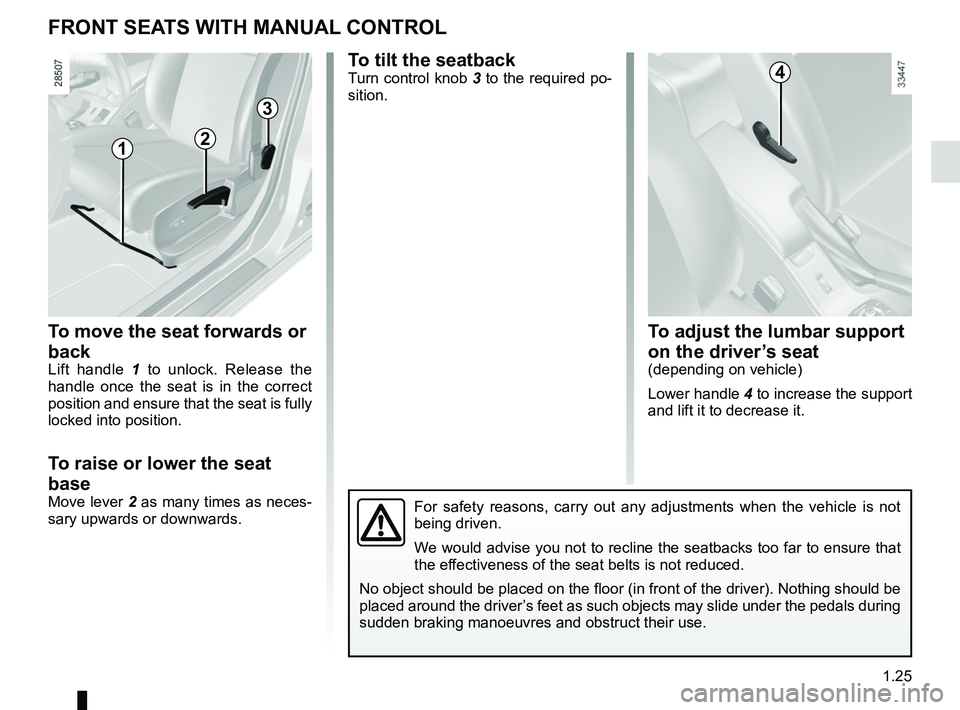
front seat adjustment ............................(up to the end of the DU)
front seats adjustment ...................................... (up to the end of the DU)
front seats with manual controls ........................................ (current page)
1.25
ENG_UD23710_3
Sièges avant à commandes manuelles (L38 - X38 - Renault)
ENG_NU_914-4_L38e_Renault_1
FrONt SeA tS With mANUAl cONtrOl
to move the seat forwards or
back
Lift handle 1 to unlock. Release the
handle once the seat is in the correct
position and ensure that the seat is fully
locked into position.
t o raise or lower the seat
base
Move lever 2 as many times as neces-
sary upwards or downwards.
t o tilt the seatbackTurn control knob 3 to the required po-
sition.
For safety reasons, carry out any adjustments when the vehicle is not
being driven.
We would advise you not to recline the seatbacks too far to ensure that
the effectiveness of the seat belts is not reduced.
No object should be placed on the floor (in front of the driver). Nothing should be
placed around the driver’s feet as such objects may slide under the pedals during
sudden braking manoeuvres and obstruct their use.
1
3
2
4
t o adjust the lumbar support
on the driver’s seat
(depending on vehicle)
Lower handle 4 to increase the support
and lift it to decrease it.
Page 32 of 195

JauneNoirNoir texte
1.27
ENG_UD25350_3
Ceintures de sécurité (L38 - X38 - Renault)
ENG_NU_914-4_L38e_Renault_1
UnfasteningPress button 4 and the seat belt will be
rewound by the inertia reel. Guide the
belt into position.
™Front seat belt reminder
warning light
It lights up on the central display when
the engine is started and, if the driv -
er’s seat belt is not fastened, the light
flashes and a beep sounds for about
two minutes when the vehicle reaches
a speed of approximately 12 mph
(20 km/h).
NB: an object placed on the passenger
seat cushion may activate the warning
light in some cases.
SeA t BeltS (2/3)
locking
Unwind the belt slowly and smoothly
and ensure that buckle 3 locks into
catch 5 (check that it is locked by pull -
ing on buckle 3). If the belt jams, allow
it to return slightly before attempting to
unwind it again.
If your seat belt is completely jammed,
pull slowly, but firmly, so that just over
3 cm unwinds. Allow it to return slightly
before attempting to unwind it again.
If there is still a problem, contact an ap-
proved dealer.
1
5
34
5
Adjusting the front seat belt
height
Press button 6 to adjust the seat belt
height so that the shoulder strap 1 is
worn as shown previously:
– to lower the seat belt, press button 6
and lower the seat belt at the same
time;
– to raise the seat belt, press button 6
and raise the seat belt at the same
time.
Make sure that the seat belt is locked
in position correctly after you have ad-
justed it.
6
Page 34 of 195
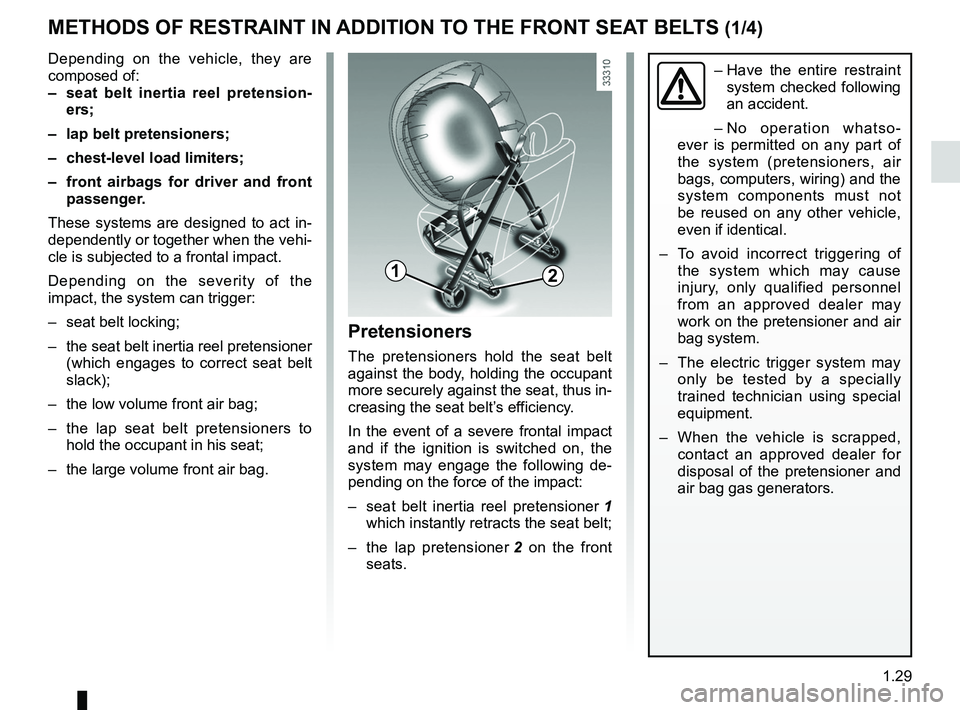
seat belts .............................................. (up to the end of the DU)
additional methods of restraint ............. (up to the end of the DU)
additional methods of restraint to the front seat belts ......................(up to the end of the DU)
additional methods of restraint to the rear seat belts .......................(up to the end of the DU)
air bag ................................................... (up to the end of the DU)
air bag ................................................... (up to the end of the DU)
pretensioners ........................................ (up to the end of the DU)
seat belt pretensioners front seat belt .................................. (up to the end of the DU)
seat belt pretensioners ......................... (up to the end of the DU)
methods of restraint in addition to the seat belts
(up to the end of the DU)
1.29
ENG_UD23032_2
Dispositifs complémentaires à la ceinture avant (L38 électriqu\
e - Renault)
ENG_NU_914-4_L38e_Renault_1
Methods of restraint in addition to the child seat belts
methODS OF reStrAiNt iN ADDitiON t O the FrONt SeAt BeltS (1/4)
Depending on the vehicle, they are
composed of:
– seat belt inertia reel pretension -
ers;
– lap belt pretensioners;
– chest-level load limiters;
– front airbags for driver and front
passenger.
These systems are designed to act in-
dependently or together when the vehi-
cle is subjected to a frontal impact.
Depending on the severity of the
impact, the system can trigger:
– seat belt locking;
– the seat belt inertia reel pretensioner
(which engages to correct seat belt
slack);
– the low volume front air bag;
– the lap seat belt pretensioners to
hold the occupant in his seat;
– the large volume front air bag.
Pretensioners
The pretensioners hold the seat belt
against the body, holding the occupant
more securely against the seat, thus in-
creasing the seat belt’s efficiency.
In the event of a severe frontal impact
and if the ignition is switched on, the
system may engage the following de -
pending on the force of the impact:
– seat belt inertia reel pretensioner 1
which instantly retracts the seat belt;
– the lap pretensioner 2 on the front
seats.
– Have the entire restraint
system checked following
an accident.
– No operation whatso -
ever is permitted on any part of
the system (pretensioners, air
bags, computers, wiring) and the
system components must not
be reused on any other vehicle,
even if identical.
– To avoid incorrect triggering of
the system which may cause
injury, only qualified personnel
from an approved dealer may
work on the pretensioner and air
bag system.
– The electric trigger system may
only be tested by a specially
trained technician using special
equipment.
– When the vehicle is scrapped,
contact an approved dealer for
disposal of the pretensioner and
air bag gas generators.
12
Page 37 of 195
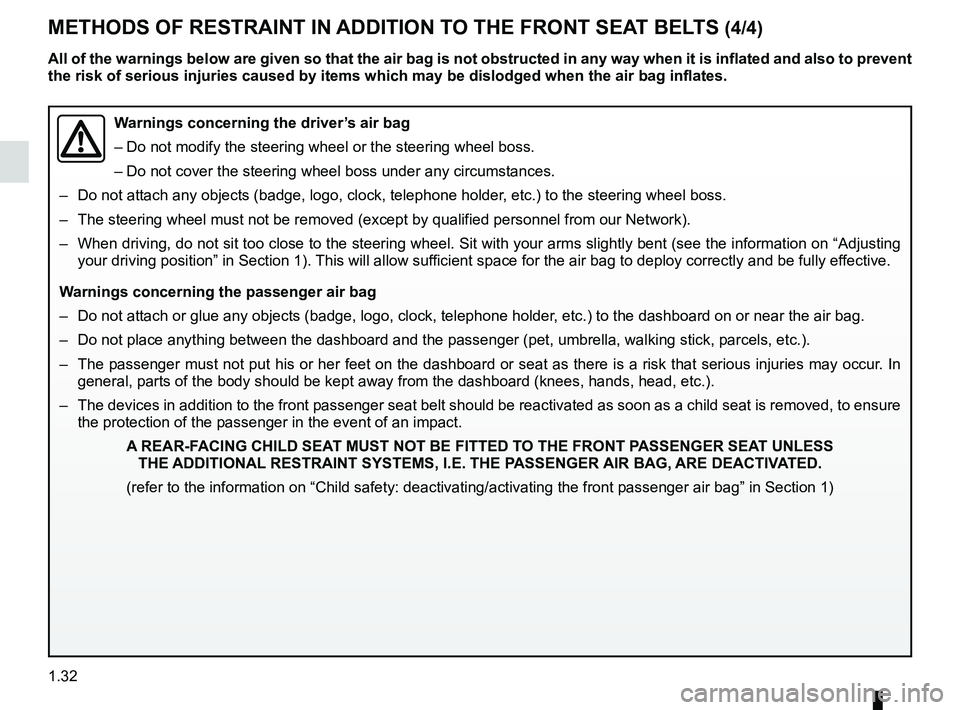
1.32
ENG_UD23032_2
Dispositifs complémentaires à la ceinture avant (L38 électriqu\
e - Renault)
ENG_NU_914-4_L38e_Renault_1
methODS OF reStrAiNt iN ADDitiON t O the FrONt SeAt BeltS (4/4)
Warnings concerning the driver’s air bag
– Do not modify the steering wheel or the steering wheel boss.
– Do not cover the steering wheel boss under any circumstances.
– Do not attach any objects (badge, logo, clock, telephone holder, etc.) to the steering wheel boss.
– The steering wheel must not be removed (except by qualified personnel from our Network).
– When driving, do not sit too close to the steering wheel. Sit with your arms slightly bent (see the information on “Adjusting
your driving position” in Section 1). This will allow sufficient space for the air bag to deploy correctly and be fully effective.
Warnings concerning the passenger air bag
– Do not attach or glue any objects (badge, logo, clock, telephone holder, etc.) to the dashboard on or near the air bag.
– Do not place anything between the dashboard and the passenger (pet, umbrella, walking stick, parcels, etc.).
– The passenger must not put his or her feet on the dashboard or seat as there is a risk that serious injuries may occur. In
general, parts of the body should be kept away from the dashboard (knee\
s, hands, head, etc.).
– The devices in addition to the front passenger seat belt should be reactivated as soon as a child seat is removed, to ensure
the protection of the passenger in the event of an impact.
A reAr-FAciNg chilD SeA t mUSt NOt Be FitteD tO the FrONt PASSeNger SeA t UNleSS
the ADDitiONAl reStrAiNt SYStemS, i.e. the PASSeNger Air BAg, Are DeActiv AteD.
(refer to the information on “Child safety: deactivating/activating \
the front passenger air bag” in Section 1)
All of the warnings below are given so that the air bag is not obstructed in any way when it is inflated and also to prevent
the risk of serious injuries caused by items which may be dislodged when\
the air bag inflates.
Page 41 of 195
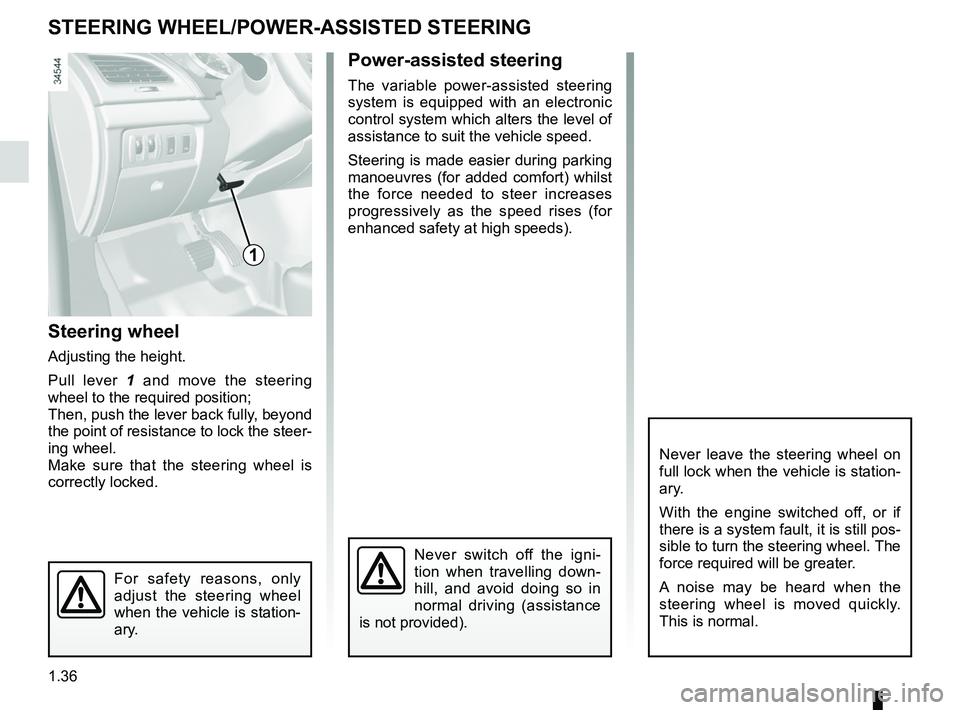
steering wheeladjustment ...................................... (up to the end of the DU)
power-assisted steering ........................(up to the end of the DU)
power-assisted steering ........................(up to the end of the DU)
1.36
ENG_UD26160_3
Volant de direction (L38 - X38 - Renault)
ENG_NU_914-4_L38e_Renault_1
Power-assisted steering
The variable power-assisted steering
system is equipped with an electronic
control system which alters the level of
assistance to suit the vehicle speed.
Steering is made easier during parking
manoeuvres (for added comfort) whilst
the force needed to steer increases
progressively as the speed rises (for
enhanced safety at high speeds).
Steering wheel/Power-assisted steering
SteeriNg Wheel/POWer-ASSiSteD SteeriNg
Steering wheel
Adjusting the height.
Pull lever 1 and move the steering
wheel to the required position;
Then, push the lever back fully, beyond
the point of resistance to lock the steer-
ing wheel.
Make sure that the steering wheel is
correctly locked.
For safety reasons, only
adjust the steering wheel
when the vehicle is station-
ary.
1
Never switch off the igni -
tion when travelling down -
hill, and avoid doing so in
normal driving (assistance
is not provided).
Never leave the steering wheel on
full lock when the vehicle is station-
ary.
With the engine switched off, or if
there is a system fault, it is still pos-
sible to turn the steering wheel. The
force required will be greater.
A noise may be heard when the
steering wheel is moved quickly.
This is normal.
Page 42 of 195
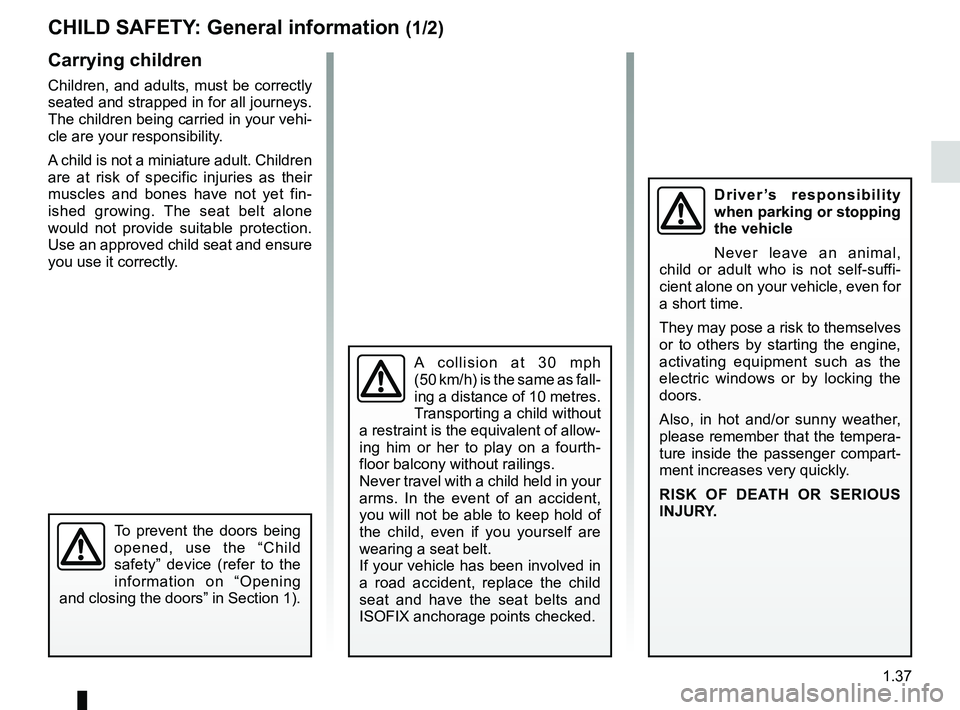
child safety............................................ (up to the end of the DU)
child restraint/seat ................................ (up to the end of the DU)
child restraint/seat ................................ (up to the end of the DU)
child restraint/seat ................................ (up to the end of the DU)
child seats ............................................. (up to the end of the DU)
transporting children ............................. (up to the end of the DU)
children ................................................. (up to the end of the DU)
1.37
ENG_UD21916_3
Sécurité enfants : généralités (X35 - L35 - X45 - H45 - \
X65 - X81 - X85 - X83 - B95 - D95 - K95 - J95 - R95 - L38 - X38 - X32 - \
Renault)
ENG_NU_914-4_L38e_Renault_1
Child safety: general information
chilD SAFetY : general information (1/2)
carrying children
Children, and adults, must be correctly
seated and strapped in for all journeys.
The children being carried in your vehi-
cle are your responsibility.
A child is not a miniature adult. Children
are at risk of specific injuries as their
muscles and bones have not yet fin -
ished growing. The seat belt alone
would not provide suitable protection.
Use an approved child seat and ensure
you use it correctly.
A collision at 30 mph
(50 km/h) is the same as fall-
ing a distance of 10 metres.
Transporting a child without
a restraint is the equivalent of allow-
ing him or her to play on a fourth -
floor balcony without railings.
Never travel with a child held in your
arms. In the event of an accident,
you will not be able to keep hold of
the child, even if you yourself are
wearing a seat belt.
If your vehicle has been involved in
a road accident, replace the child
seat and have the seat belts and
ISOFIX anchorage points checked.
To prevent the doors being
opened, use the “Child
safety” device (refer to the
information on “Opening
and closing the doors” in Section 1).
D r i v e r ’s r e s p o n s i b i l i t y
when parking or stopping
the vehicle
Never leave an animal,
child or adult who is not self-suffi -
cient alone on your vehicle, even for
a short time.
They may pose a risk to themselves
or to others by starting the engine,
activating equipment such as the
electric windows or by locking the
doors.
Also, in hot and/or sunny weather,
please remember that the tempera-
ture inside the passenger compart-
ment increases very quickly.
ri SK OF D eAth Or S eri OUS
iNJUr Y.
Page 45 of 195

towing rings .......................................... (up to the end of the DU)
child restraint/seat ................................ (up to the end of the DU)
child restraint/seat ................................ (up to the end of the DU)
child safety ............................................ (up to the end of the DU)
child seats ............................................. (up to the end of the DU)
child restraint/seat ................................ (up to the end of the DU)
transporting children ............................. (up to the end of the DU)
1.40
ENG_UD23036_3
Sécurité enfants : choix de la fixation du siège enfant (L38 é\
lectrique - Renault)
ENG_NU_914-4_L38e_Renault_1
Jaune NoirNoir texte
Choosing a child seat mounting
chilD SAFetY : choosing a child/baby seat mounting (1/2)
There are two ways of attaching child
seats: via the seat belt or using the
ISOFIX system.
Attachment via the seat belt
The seat belt must be adjusted to
ensure that it is effective in the event of
harsh braking or an impact.
Ensure that the strap paths indicated
by the child seat manufacturer are re-
spected.
Always check that the seat belt is cor-
rectly fastened by pulling it up, then
pulling it out fully whilst pressing on the
child seat.
Check that the seat is correctly held by
moving it from side to side and back
to front: the seat should remain firmly
fixed.
Check that the child seat has not been
installed at an angle and that it is not
resting against a window. Attachment using the iSOFiX
system
Authorised ISOFIX child seats are ap
-
proved in accordance with regulation
ECE-R44 in one of the three following
scenarios:
– ISOFIX universal 3-point forwardfac-
ing seat
– ISOFIX semi-universal 2-point seat
– specific
For the latter two, check that your child
seat can be installed by consulting the
list of compatible vehicles.
Attach the child seat with the ISOFIX
locks, if these are provided. The ISOFIX
system allows quick, easy, safe fitting.
The ISOFIX system consists of 2 rings
and, in some cases, a third ring.
Before using an ISOFIX
child seat that you pur -
chased for another vehicle,
check that its installation is
authorised. Consult the list of ve -
hicles which can be fitted with the
seat from the equipment manufac -
turer.
No modifications may be
made to the component
parts of the restraint system
(ISOFIX seat belts, seats
and their mountings) originally fitted.
The seat belt must never
be twisted or the tension
relieved. Never pass the
shoulder strap under the
arm or behind the back.
Check that the seat belt has not
been damaged by sharp edges.
If the seat belt does not operate nor-
mally, it will not protect the child.
Consult an approved dealer. Do not
use this seat until the seat belt has
been repaired.
Do not use the child seat
if it may unfasten the seat
belt restraining it: the base
of the seat must not rest on
the buckle and/or catch of the seat
belt.
Page 46 of 195
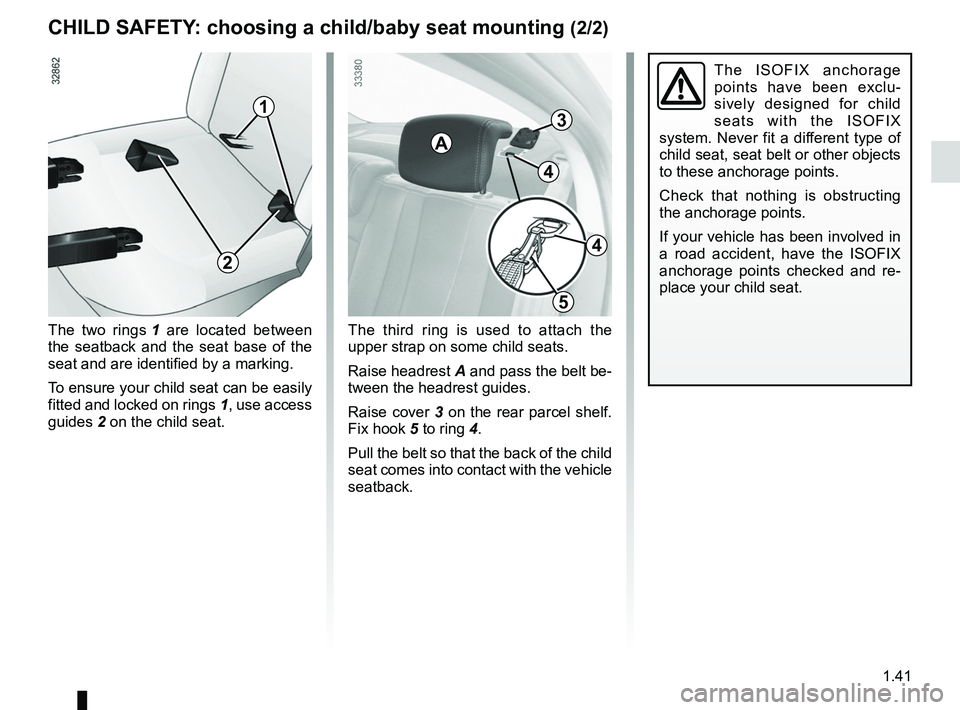
JauneNoirNoir texte
1.41
ENG_UD23036_3
Sécurité enfants : choix de la fixation du siège enfant (L38 é\
lectrique - Renault)
ENG_NU_914-4_L38e_Renault_1
chilD SAFetY : choosing a child/baby seat mounting (2/2)
The ISOFIX anchorage
points have been exclu-
sively designed for child
seats with the ISOFIX
system. Never fit a different type of
child seat, seat belt or other objects
to these anchorage points.
Check that nothing is obstructing
the anchorage points.
If your vehicle has been involved in
a road accident, have the ISOFIX
anchorage points checked and re -
place your child seat.
The third ring is used to attach the
upper strap on some child seats.
Raise headrest A and pass the belt be-
tween the headrest guides.
Raise cover 3 on the rear parcel shelf.
Fix hook 5 to ring 4.
Pull the belt so that the back of the child
seat comes into contact with the vehicle
seatback.
The two rings
1 are located between
the seatback and the seat base of the
seat and are identified by a marking.
To ensure your child seat can be easily
fitted and locked on rings 1, use access
guides 2 on the child seat.
1
2
3
4
4
A
5